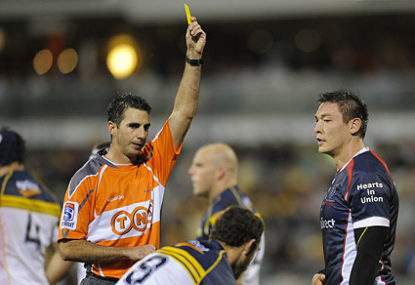LISTEN: 'Bang, Bang Queensland' - Reds forward hoping new slogan catches on across the state
Jeffery Toomaga-Allen is trying to promote rugby in Queensland and bring crowds back to Reds games.

Tomorrow night’s Reds-Waratahs game celebrates 130 years since these two now long-time rivals first met on Queensland soil, a match equably notable for being the first appearance in rugby of a referee armed with a whistle.
Played on the inner field at the Eagle Farm Racecourse, the game was refereed by long-time NSWRU official Monty Arnold.
The first Queensland team had been formed the year before and come to Sydney for a series of matches, including a 26-4 loss to NSW at the Sydney Cricket Ground.
The Queenslanders that formed the representative teams in 1882 and ’83 were from the senior clubs in Brisbane and Ipswich who had founded the QFA in 1880. Though this body adopted the Victorian Football Association’s playing laws (Australian rules), it allotted each fourth Saturday aside for the clubs to meet playing games under rugby laws.
Arnold, who was also the 1883 NSW team’s tour manager, was concerned that the Queenslanders were still novices when it came to understanding the intricacies of the rugby law book and the game’s unwritten customs and traditions.
He struck upon the idea of using a policeman’s whistle to call a halt to play when an infringement occurred or a scrum required. In Victorian times the shrill of a policeman’s whistle was sufficient to immediately and forcibly grab everyone’s immediate attention.
So what was used before Arnold’s innovation? A hunting horn perhaps? No, rather a convoluted system of officials waving flags and shouting at the top of their lungs.
As we all have seen ourselves, even a whistle on occasion isn’t heard by every player on the field in the heat of battle, so you can well imagine that games under this flag and yelling scheme were not always successfully brought to an immediate halt.
Remarkably, the 1883 NSW-Queensland contest may not only be the first to be under the command of a whistle, but the earliest instance of a first class match being officiated by a single referee, the system used today.
Rugby games in the late 1870 and through the 1880s were managed by two umpires and a referee. Under this model each team brought to the game an umpire, whose role was to act as an advocate for their side in disputes.
The players, cricket-style, would appeal to their team’s umpire with raised hands and shouts if they thought they saw their opposition commit a breach of the laws (of course, if it didn’t disadvantage them, they wouldn’t appeal).
If their umpire agreed, he would raise his flag high in the air.
There was an expectation that umpires would honourably carry out their duties. If the other team’s umpire agreed there had been an infringement, he too would raise his flag. Upon seeing two flags in the air, the referee would raise his arms and shout for the game to stop.
However, if only one umpire put his flag up, the game did not stop. It was only halted if the referee agreed that a law had been broken.
It is not hard to deduce that a referee was in a difficult position – he had to somehow watch for one or two flags to be raised, while also looking out for infringements. If the referee saw a breach during play, but neither umpire put up his flag, he had to remain silent, and could not intervene at all.
Not that every captain simply gave up if his team’s umpire raised a flag and the other officials ignored it – the skipper would simply call a stop to the game anyway.
Often it was done for no other reason than to catch a breather or to cut-short the opposing team’s attack. It was unfair, ungentlemanly, but it was done.
What ensued was a protracted discussion between the three officials, the two captains, the two teams, and even nearby spectators, all offering their own opinions. Play was often suspended for minutes on end while the on-field debate raged on.
Recourse to the rule book itself on the field was far from unheard of.
The use of a whistle in rugby and other football codes soon spread across the Australasian colonies. After the New Zealand team that visited Sydney in 1884 returned home to Christchurch, officials in Auckland began using whistles.
In 1886 in Melbourne a game between Fitzroy and Carlton became the first Australian rules match umpired using a whistle.
Soccer too in Sydney adopted the whistle (which may be the earliest occurrence in that code – an 1878 meeting of Nottingham Forest and Sheffield Norfolk is claimed to be the first, but the clubs never met that year, and no other instances in Britain can be found until the 1890s).
The RFU made the whistle mandatory for referees in 1886, and replaced the two umpires system for the 1888/89 season. The referee was given sole control of the field, while the two umpires were consigned to a touchline (thus giving us the “touch judge”) and behind the goal posts, and players were told to stop appealing.
As for that first game in 1883, the Queenslanders mounted a remarkable comeback, turning an 11-2 deficit late in the game into a 12-11 victory over the New South Welshmen.
Wild scenes erupted when Arnold blew his whistle to indicate full-time. Many of the home side were carried shoulder high from the field.
The fact that Queensland had beaten “the Mother colony” gave great impetus to Rugby in the colony. Within months the QRU was founded, and by the end of the decade rugby had taken the ascendancy from Australian rules.